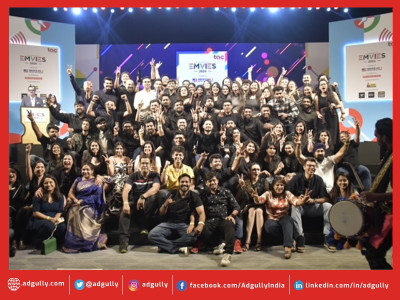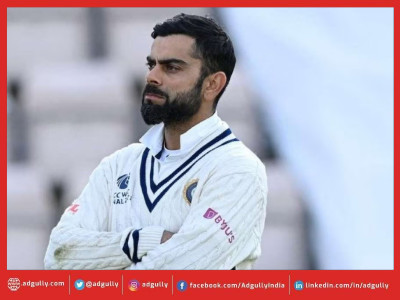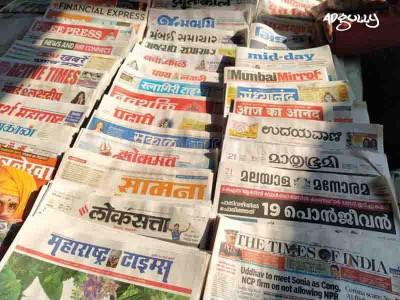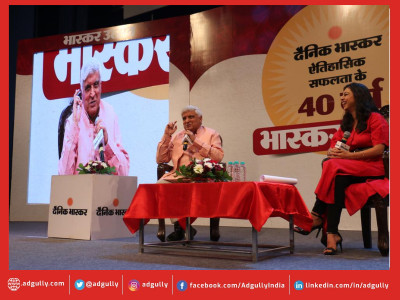Renewed optimism amid old problems as print industry looks forward to 2019
Bogged down by several factors in the last few years, the print industry is looking forward to a more positive scenario in 2019. All eyes are on the declaration of the latest round of the Indian Readership (IRS) data, which is expected in January-end or February. Data collection work has already commenced. The Lok Sabha elections are also a buoyant factor for the print industry.
However, rise in newsprint costs continues to be a serious problem as is the threat from the digital sector.
Adgully spoke to a cross-section of print players to understand the current dynamics dictating the print industry and the way forward.
Market dynamics dictating the print industry in India today
Girish Agarwal, Director, Dainik Bhaskar, noted that readers are changing and so now all the print organisations are looking at readers from a different innovative perceptive every day – be it in terms of the format of the newspaper or content. The format of reporting is changing along with the growth of print.
According to Krishna Menon, CMO, Sakal Media Group, the print industry has been in a constant flux in the last decade or so. With increasing digitalisation, media houses have had to relook at how they deliver relevant content to the audiences. “For example, post May 2018, the print industry has been impacted by the rising newsprint costs. China has stopped exporting newsprint. We are now dependent on other countries at much higher costs. Moreover, advertisers have many more platforms to advertise than just the traditional media, which is Print, TV, Radio or Outdoor. While digital advertising provides a certain level of transparency, mass impact continues to come through a mix of traditional and non-traditional platforms intelligently. All these factors play a role in how the industry is shaping up.”
“The Indian print industry has been a testament to the importance of small town and rural markets,” observed Kamal Krishnan, National Head, Media Solutions (Print), Mathrubhumi. Amidst the competition from digital media, the Indian print industry stands strong (unlike its western counterparts) on the back of growing demand from the regional markets. Krishnan pointed out that the cover price of the newspaper in India is very low and affordable. “They cost no more than Rs 200 per month ($3), which is close to the cost of a single newspaper per day in the US. Also, since most newspapers in India are delivered to customers’ homes every morning, it makes them very accessible and convenient. The industry continues to grow on the back of demographic and socio-economic factors, rising literacy levels, improved penetration and hyper- localisation. The increase in affluence and consumption levels in regional markets has been the key growth driver for print today,” he added.
Sanjeev Bhargava, Brand Director, Times Group, added here that in a scenario where ad spends are increasing, the newsprint industry faces unique challenges like increasing newsprint prices and flight of news consumption away from print. However, there is a ray of hope that stems from the fact that the country is also opening up and a new breed of English speaking readers is entering the market. “It is up to us to deliver to these readers and to the marketing community,” he said.
Another factor that works in print’s favour is the huge consumer trust value that has been present across generations. As stated by Shalini Gupta, Vice President, Brand & Communication, Lokmat Media Group, “Readers relate to their newspaper as ‘something of their own’ since they subscribe to it individually and there is pride in defending news read in the newspaper that morning or earlier.”
Factors driving the growth of Print Industry in India
For Lokmat’s Shalini Gupta, hyper-localisation, direct ROI for schemes and offers driving consumer behaviour and speed of going to market are factors that give a boost to the print industry. “For example, a great win by any of our sports team is printed in the newspaper first, thus turning around current trending topic to brand advantage. Digital, of course, adds to this.”
Sanjeev Bhargava, too, highlighted the ability of print to deliver targeted combination of reach and impact, coupled with competitive advantages like innovations and many other value-adds by virtue of the product being physical delivered to the doorstep of the consumer every day at a relatively low cost. “This keeps the industry buoyant even today and will continue to do so for some time to come,” he affirmed.
Challenges
According to Krishna Menon, digital media has been a large driver of change. “Every newspaper house is looking at digital as print is becoming more and more expensive. Digital may not necessarily get them the ROIs or the expected revenues, but they are still willing to experiment in this space to see how it works for them,” he added.
Echoing similar views, Kamal Krishnan, too, explained that as Internet access expands, the digital threat continues to worsen for print players. There is a swing in consumption habits of readers, where preference is more towards mediums which are available 24x7.
He further said, “The social media and internet accesses penetration in smaller towns and villages will change the way how people consume news. Having said that, the rising cost of newsprint has also become a worrisome factor for the print players and needs a strategic solution.”
“The primary challenge is that the young decision makers of today, both in media agencies and in marketing, are unaware of the impact print can have in their media plan. It is incumbent upon the newspaper industry to ensure the true value of print is communicated to the buying community both in terms of relevance and in terms of ROI,” remarked Times Bhargava.
According to Girish Agarwal, “The challenges that we are facing in today’s time is growth in newsprint hike. Secondly, all the national advertisers have a bit shaky mindset that digital is moving. So, I think they also need to focus on print now.”
Lokmat’s Gupta, too, agreed that newsprint prices have skyrocketed and added that the younger audience is moving towards digital medium for news consumption.
IRS’ contribution to overall print growth
The IRS 2017 numbers indicate that the regional media houses are growing. The regionals space has seen healthy growth and engagement. “I see a lot of growth in our market as literacy rate is growing. Vernacular will stand the test. However, we will have to create avenues where readers find you as a credible source of news and information, delivered in a palatable format,” noted Sakal Media Group’s Krishna.
Dainik Bhaskar’s Agarwal added here that the IRS has given a boost to everybody in terms of confidence. “The next report (expected by the end of January 2019) will let us know the performance of print,” he added.
Bhargava, too, agreed that “IRS plays a critical role in educating decision makers on the width and depth of print reach in measurable terms. In my experience, the data has thrown up enough information for current decision makers and influencers to relook at their own perspectives on print, largely in favour of print. IRS will continue to play this critical role in the future as well.”
The IRS has been promising on most fronts, the most important being to establish a currency of measurement for the print industry. “In Mathrubhumi’s case, the research was able to garner more readers and advertising revenue for the company, it was very promising to see that every second Malayalee was reading our newspaper,” said Kamal Krishnan.
“The industry has welcomed IRS data as it brings forth huge credibility due to its methodology, reach, accuracy and expanse of coverage,” remarked Gupta. She further added, “It has clearly showed how over the last 5 years English newspapers have shown a decline, whereas regional news has increased. Overall rural readership has also improved. It not only affirmed Lokmat’s No. 1 leadership in Maharashtra, but also declared Lokmat as the new No. 1 in Pune.”
Advertising Revenues
Print is here to stay, affirmed Mathrubhumi’s Krishnan, adding that the general expectation is that the government is likely to support all the sectors in the run-up to the 2019 Lok Sabha Elections. “Besides, the gains from implementation of GST should also begin to flow in the economy, and the investment in infrastructure and rural schemes should put more money in the hands of consumers, which will lead to a buoyant economy. Print heavy verticals like Real Estate have shown a strong rebound, automobile and FMCG sectors are likely to contribute as well,” he added.
Sanjeev Bhargava, too, stated that “There is an increasing fragmentation of the media spends as we move forward. This is because multitudes of media opportunities are opening up for the marketers to choose from. It is incumbent on the print industry to retain its share of the pie by becoming more innovative, more engaging and more participative in the marketing programs of the industry.”
“Ad revenues are growing. But are we able to shoot beyond the double-digit mark? No. Are we able to grow in the single-digit ratio? Yes,” remarked Sakal’s Krishna.
He further said, “At Sakal, we have stayed far away from such offers. We have a relationship with our readers in Maharashtra and all over the world through our digital assets. The readers have placed their trust in us and this is something advertisers and media-buying agencies have recognised as we are in close touch with all of them. The current cost escalations in the industry are felt most acute by the players who have tried to game this system and are facing the brunt of such unsustainable measures.”
Impact of rise in Newsprint cost
“The impact may not be in the long-term, but definitely in the short-term. In the long-term, I think it will stabilise. Overall, the impact will be 15-20 per cent,” opined Krishna.
He further said, “Fortunately for us, we also had long term deals on paper, which insulated us from the impact to a great extent. Without making any change to the cover price, we’ve ensured that we have enhanced our product and driven efficiencies through technology and better utilisation of our assets. We have invested in modernisation of our business and upgradation of our printing presses over 7-8 years ago and are reaping the benefits of that foresight now. We continue to keep a close eye on costs and ensure we are harnessing technology to reduce inefficiencies. This is not something we do reactively but as a matter of continuous operational performance.”
On the contrary, Kamal Krishna felt that the impact will be more in the long-term than at present. “It is likely to put 30-40 per cent additional burden on the print players,” he added.
Sanjeev Bhargava remarked, “It will certainly cause some serious hiccups from the profitability point of view, but the industry is optimistic that the price rise is temporary and will come down to manageable levels. It all depends on the volume of printing as it is a variable cost.”
“While newsprint cost has impacted the business, we feel it is imperative to change gears and work towards more unique and innovative brand led offerings,” said Lokmat’s Gupta.
The Way forward
Dainik Bhaskar’s Agarwal maintained that to attain a sustained growth, one has to increase the penetration.
More innovative solutions for lasting impact of brands in their medium was the way forward, according to Gupta.
For Kamal Krishna, every business needs to ensure that costs are kept in check. According to him, “The growth of the business is dependent on two key ingredients – the revenues we are able to make and inversely, the costs we are able to optimise. Sakal is a proven product for the last 87 years, but we still continue to make continuous changes to cater to the changing reading habits of our readers. You can’t be talking of global news and not be highlighting the local news that concerns them. Sakal not only believes in providing relevant news but also adding value to every reader’s life.”
“Print companies are continuing to focus on digital, activations and event solutions to shore up the revenue and maintain growth at the same time. Digital newspaper revenues in India are set for rapid growth,” concluded Krishna.

















Share
Facebook
YouTube
Tweet
Twitter
LinkedIn